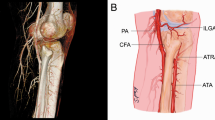Summary
The management of severe compound tibial fractures is aimed at obtaining osseous consolidation, proper cutaneous and muscular cover, absence of infection and restoration of limb function. A knowledge of the cutaneous and muscular vascularisation allows the surgeons to use many flaps in a rational and predictable manner. One of the most commonly used flaps is the soleus muscular flap. This may be used as a proximally or distally based muscular flap and the use of a hemisoleus flap has also been described. A morphometric analysis of the relation between tibial length and soleus vascular pattern provides a simple and reliable method for planning this flap preoperatively. The study was performed on fresh and preserved cadavers.
Résumé
Le traitement des fractures largement ouvertes du tibia vise à obtenir la consolidation osseuse, la couverture musculaire et cutanée, pour combattre l'infection et faciliter la restauration fonctionnelle du membre inférieur. La connaissance de la vascularisation cutanée et musculaire permet au chirurgien d'utiliser de nombreux lambeaux de façon rationnelle et prédictible. L'un des lambeaux les plus utilisés est le lambeau musculaire de soléaire. Il peut être utilisé comme lambeau musculaire à pédicule proximal ou distal, l'utilisation de lambeau d'hémi-soléaire a également été décrite. Grâce à une analyse morphométrique des rapports unissant la longueur du tibia et la disposition vasculaire du m. soléaire, nous proposons une méthode simple et fiable pour planifier ce lambeau avant l'intervention. L'étude a été réalisée sur des cadavres frais et embaumés.
Similar content being viewed by others
References
Arnold PG, Irons GB (1984) Lower-extremity muscle flaps. Orthop Clin North Am 15: 441–449
Bonnel F, Chevrel JP, Outrequin G (1991) Anatomie clinique: Les membres. Springer-Verlag France, Paris, pp 590–591
Fayman MS, Orak F, Hugo B, Berson D (1987) The distally based split soleus muscle flap. Br J Plast Surg 40: 20–26
Gustilo RB, Mendoza RM, Williams DN (1984) Problems in the management of type III (severe) open fractures: a new classification of type III open fractures. J Trauma 24: 742–746
Leclercq C, de Normandie Ph, Brunelli F (1987) Couverture cutanée du tiers inférieur de la jambe par le lambeau soléaire distal. Ann Chir Plast 32: 140–143
Manchot C (1983) The cutaneous arteries of the human body. Springer-Verlag, New York
Masquelet AC, Romaña MC (1988) Vascularisation tégumentaire des membres et applications chirurgicales. Rev Chir Orthop 74: 669–675
Masquelet AC, Gilbert A, Romaña MC (1990) Les lambeaux de couverture au membre inférieur. Springer-Verlag France, Paris, pp 45–57
Masquelet AC (1993) Réparation des pertes de substance des parties molles au membre inférieur. Symposium SOFCOT, pp 18–19
Mathes SJ, Nahai F (1979) Clinical atlas of muscle and musculocutaneous flaps. CV Mosby, St. Louis
Rees MJW, Taylor GI (1986) A simplified lead oxide cadaver injection technique. Plast Reconstr Surg 77: 141–145
Sadasivan KK, Odgen JT, Albright JA (1991) Anatomic variations of the blood supply of the soleus muscle. Orthopedics 14: 679–683
Salmon M (1936) Artères de la peau. Masson, Paris
Tobin GR (1985) Hemisoleus and reversed hemisoleus. Plast Reconstr Surg 76: 87–96
Townsend PL (1978) An inferior based soleus flap. Br J Plast Surg 31: 210–213
Wright J.K, Watkins RP (1981) Use of the soleus muscle flap to cover part of the distal tibia. Plast Reconstr Surg 68: 957–958
Wu WC, Chang YP, So YC, Yip SF, Lam YL (1993) The anatomic basis and clinical applications of flaps based on the posterior tibial vessels. Br J Plast Surg 46: 470–479
Author information
Authors and Affiliations
Rights and permissions
About this article
Cite this article
Lopez-Casero, R., De Pedro, J., Rodriguez, E. et al. Distal vascular pedicle-hemisoleus to tibial length ratio as a main predictive index in preoperative flap planning. Surg Radiol Anat 17, 113–119 (1995). https://doi.org/10.1007/BF01627570
Received:
Accepted:
Issue Date:
DOI: https://doi.org/10.1007/BF01627570




